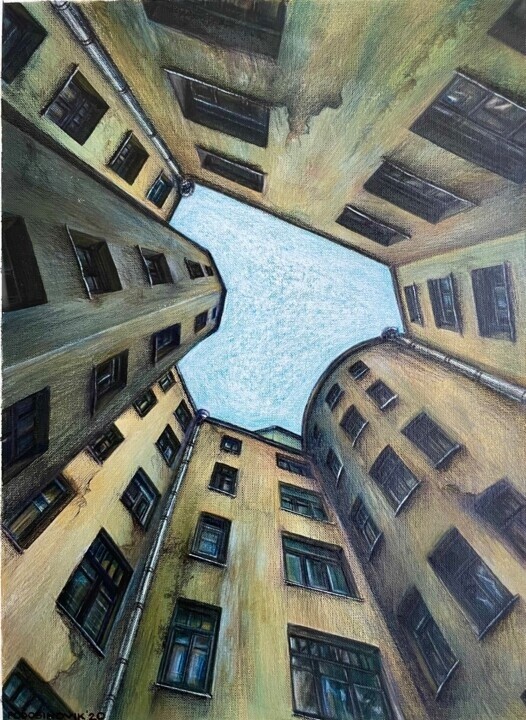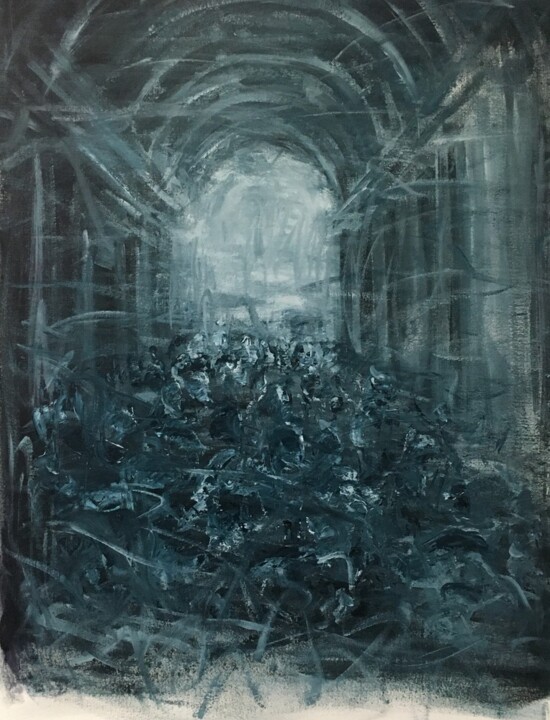 Gaetano Ligrani, The ball game, 2022. Oil on canvas, 80 x 100 cm.
Gaetano Ligrani, The ball game, 2022. Oil on canvas, 80 x 100 cm.
The concept of contamination between the arts
The concept of contamination between different arts turns out to be not only very old, but also highly multifaceted and articulated, as the aforementioned exchanges are the result of interactions aimed at involving different levels and multiple conceptual, stylistic, perspective and chromatic directions. Simply put, such influences occur predominantly when an art, which achieves relevant levels of innovation, manages to connect with other creative manifestations. In particular, the combination of painting and architecture has stood out over the centuries, which was also realized through the multifaceted figures of artist-architects, such as, for example, the well-known Italian Renaissance masters Michelangelo Buonarroti and Raphael Sanzio. In addition, such contamination is found in the works themselves, so much so that it is possible to admire Italian frescoes dating as far back as the first century B.C., aimed at imitating the marble columns of buildings. Indeed, architecture can be found in many paintings and illuminations, although at first it was used as a mere background and, only from the Renaissance period onward, began to be employed to emphasize perspective by creating depth. In addition, only later, and more precisely from the 16th century, did architectural painting, a genre whose exclusive motif is architecture, develop in Western art, beginning in Flanders. In this context, it turns out to be decisive not only the reliable perception of the styles and characters of buildings, but also the clear presentation of their spatial unfolding, within which perspective plays a decisive role.
 Aleksandra Podosinovik, Looking up in a well-backyard, 2020. Acrylic / pastel / pencil on paper, 40 x 30 cm.
Aleksandra Podosinovik, Looking up in a well-backyard, 2020. Acrylic / pastel / pencil on paper, 40 x 30 cm.
 Stasd, Red trinagol, 2021. Tempera on paper, 110 x 90 cm.
Stasd, Red trinagol, 2021. Tempera on paper, 110 x 90 cm.
The Marriage of the Virgin and The Ideal City: Masterpieces in which painting and architecture merge
The Marriage of the Virgin (1504) by Raphael Sanzio
Among the undisputed masterpieces of the Italian Renaissance, it is imperative to mention Raphael's The Marriage of the Virgin (1504), an oil painting on panel aimed at illustrating a theme completely unrelated to the New Testament, but widespread in the iconography of the time. The origin of this popular subject is due to the narration of an episode contained in the Book of John, which recounts the choice of Joseph among many suitors and the subsequent marriage between them and the Virgin. Precisely for the purpose of highlighting this happy event, the Italian master placed the wedding scene in the foreground, although, what most likely made the work of art iconic was the carefully curated and scenic architectural backdrop in a fully Renaissance style, intended to testify to Sanzio's knowledge of Leonardo's and Bramante's studies of centrally planned buildings. In addition, the ordered geometric relationships of the portrayed architectures carry an additional message, as they represent a tangible manifesto of the ideal beauty pursued in the Renaissance, aimed at alluding to universal harmonic structure and divine perfection.
 Raphael Sanzio, The Marriage of the Virgin, 1504. Oil on panel, 170×117 cm. Milan: Pinacoteca di Brera.
Raphael Sanzio, The Marriage of the Virgin, 1504. Oil on panel, 170×117 cm. Milan: Pinacoteca di Brera.
 Central Italian painter, The Ideal City, 1480 - 1490. Oil on panel, 67.7 x 239.4 cm. Urbino: National Gallery of the Marches.
Central Italian painter, The Ideal City, 1480 - 1490. Oil on panel, 67.7 x 239.4 cm. Urbino: National Gallery of the Marches.
The Ideal City (1480 - 1490)
Another Renaissance masterpiece more properly attributable to the genre of architectural painting is The Ideal City (1480 - 1490), in which it is only the buildings that mediate between figurative space and the process of fruition. The work, which comes from the Monastery of Santa Chiara in Urbino and is currently housed in the Galleria Nazionale delle Marche, has been attributed to several artists, chief among them the architect Luciano Laurana, a very meticulous master and the designer of the Ducal Palace in Urbino, whose classical architectural elements turn out to be very similar to the subject of The Ideal City. Despite this, scholars have currently attributed the masterpiece to a generic central Italian painter, the author of a remarkable perspective study, which has also been interpreted as a wooden backdrop of furniture or a model for a stage set. Certainly, the work, aimed at re-proposing Renaissance ideals of perfection and harmony, proposes an orderly, perfectly symmetrical city that respects the scientific principles of central perspective, explicitly rendered by the geometric design of the pavement. Describing the painting in detail, the square, made in centric linear perspective, has an imposing circular church in the center. In the exact middle of the latter, a series of rather symmetrical buildings are depicted, illuminated by light that spreads evenly over the medium, that is, without particularly pronounced shadows and with a certain uniformity of color. Finally, a spontaneous question arises from the contemplation of this masterpiece: why were the inhabitants not depicted? Probably humans, imperfect creatures, would have ruined the very concept of an ideal city, or, the artist preferred to depict a location built to perfection to be given to the citizens.
 Paddy, The Swimming Pool, 2022. Acrylic on canvas, 81 x 65 cm.
Paddy, The Swimming Pool, 2022. Acrylic on canvas, 81 x 65 cm.
 Rafferoico, Op.449 MMXVIII, 2018. Oil on canvas, 150 x 150 cm.
Rafferoico, Op.449 MMXVIII, 2018. Oil on canvas, 150 x 150 cm.
Architecture in the artworks of Artmajeur artists
Architecture is a very ancient form of expression, marked, first of all, by a material and functional character, and, secondly, by special symbolic meanings, aimed at representing the scientific thinking of man at a specific historical moment. The latter, turns out to be manifest, explicit or implicit, also of a certain political, organizational, social, propagandistic context, and much more. Consequently, figurative works depicting constructions, such as paintings and photographs, are themselves enriched with additional meanings, as well as valuable expressions of technique, aesthetics, style, and culture. The above can be strongly seen in the works of Artmajeur artists, just like those created by Pierre Leccia, Paddy, and Gabriela Horikawa.
 Pierre Leccia, Corner of an office building, 2020. Digital photograph on paper, 30 x 42 cm.
Pierre Leccia, Corner of an office building, 2020. Digital photograph on paper, 30 x 42 cm.
Pierre Leccia: Corner of an office building
The artistic production of Pierre Leccia, an experienced freelance photographer and graphic designer, often immortalizes contemporary urban architecture, aimed at illustrating, through the depiction of the environment around us, the concept of the ordinary. The intent of this research is to show how everyday life can be perceived not only for its utilitarian value, but also for its aesthetic and emotional relevance. In all of this, a predominantly minimalist orientation is outlined, which allows for the pursuit of thoughts capable of leading the user toward an introspective reading of the building, capable of detecting common places intended for us. Indeed, the corner of the building portrayed in Corner of an office building might prompt us to remember and imagine the bow of a boat parked in an innovative urban context. In terms of art history, however, it is worth highlighting how the first architectural photograph turns out to be View from the Window at Le Gras, which, created by Nicéphore Niépce, depicts the panorama captured from the photographer's home-workshop near Saint-Loup-de-Varennes.
 Paddy, Modern architecture, 2022. Acrylic on canvas, 75 x 64 cm.
Paddy, Modern architecture, 2022. Acrylic on canvas, 75 x 64 cm.
Paddy: Modern architecture
Just as per the title of the work, Paddy's painting pursues the intent of telling us a story by perfectly depicting the features of a modern building, which turns out to be the undisputed protagonist of the acrylic. That subject is immortalized through a close-up photographic perspective shot, aimed at highlighting the peculiarities of architectural minimalism. The latter trend, developed during the 1960s, represented a particular and radical change in the artistic climate, aimed at the reduction of reality and emphasis on the objecthood and physicality of the work, achieved through experimentation with elementary geometric structures. In fact, minimalist architecture is distinguished by the search for essence and purity, which is pursued through rather functional stylistic features, well outlined by the words of German architect and designer Mies van der Rohe: "Less is more."
 Gabriela Horikawa, Blue Gallery, 2022. Acrylic on canvas, 78.7 x 61 cm.
Gabriela Horikawa, Blue Gallery, 2022. Acrylic on canvas, 78.7 x 61 cm.
Gabriela Horikawa: Blue Gallery
It is important to note how, when paintings depict iconic buildings, they themselves become more interesting, as well as valuable, as they are able to synthesize, through brush strokes, indelible centuries of architectural history. An example of what has just been stated is Gabriela Horikawa's painting, which, through the timelessness conferred by the juxtaposition of dark hues with light tones, immortalizes one of the corridors of the famous Uffizi Gallery in Florence, one of the oldest and most famous museums in the world. Briefly reviewing the history of this well-known cultural venue, the Uffizi Gallery was conceived around 1560, when Cosimo I de' Medici commissioned his trusted artist Giorgio Vasari to design a palace that could house the administrative and judicial offices of the Duchy of Tuscany. The renowned art historian's design, to be located next to the Palazzo della Signoria, called for a U-shaped architectural body, enriched by a precious portico of Doric columns with an elegant and severe appearance. In 1574, after Vasari's death, the Uffizi was completed by another great architect, namely Bernardo Buontalenti, to whom we owe both the creation of the Gallery on the second floor of the building and the invention of the octagonal Sala della Tribuna.


 Olimpia Gaia Martinelli
Olimpia Gaia Martinelli























